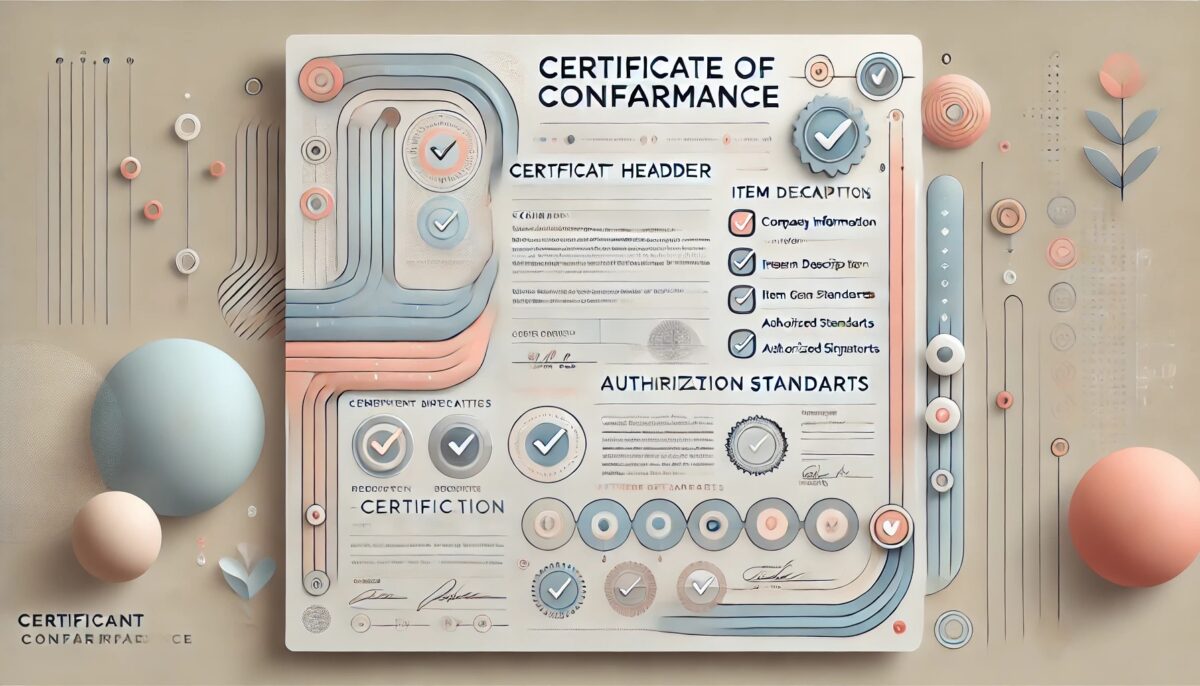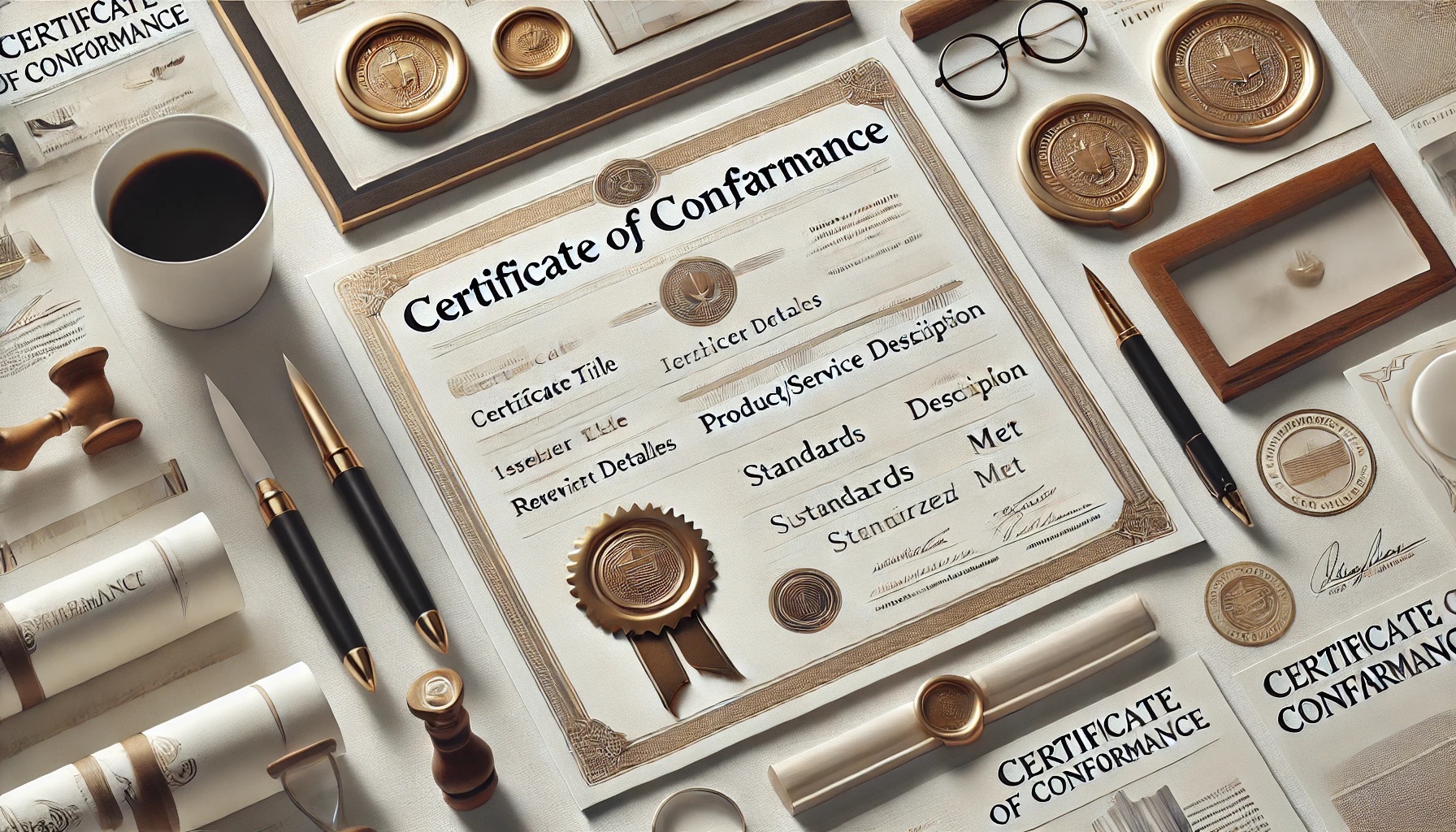Certificate of Conformance: What It Is and How to Create It

In an increasingly globalized world, the flow of imported goods plays a crucial role in meeting consumer demands. However, ensuring that these products meet safety, regulatory, and technical specifications is critical to protecting consumers and maintaining trust in international trade. This is where the Certificate of Conformance (CoC) becomes indispensable.
The Certificate of Conformance is a vital document that confirms that a product adheres to all relevant safety standards, technical requirements, and legal regulations in its target market. Whether you are importing medical devices, electronics, or consumer goods, understanding and creating a CoC ensures seamless compliance and avoids costly delays or penalties.
In this guide, we’ll delve into the intricacies of a Certificate of Conformance, its significance, and a step-by-step process for creating one. Let’s get started!

What Is a Certificate of Conformance?
A Certificate of Conformance (CoC) is a formal document that certifies that a product complies with specific standards, specifications, or regulations. These may include safety standards, industry-specific requirements, and governmental laws, depending on the destination country. The CoC serves as evidence that the product has undergone rigorous testing and meets the necessary criteria for import and sale.
Also known as a Certificate of Compliance, this document is mandatory in many industries, from electronics to pharmaceuticals. It provides a record of the product’s quality and safety, ensuring that it meets consumer expectations and regulatory demands.
Why Is a Certificate of Conformance Important?
Having a CoC in place offers a range of benefits for businesses and their products. Here are some key reasons why it is indispensable:
1. Regulatory Compliance
Different countries have unique safety standards and regulations for imported products. A CoC ensures that your product meets these requirements, facilitating smooth entry into foreign markets.
2. Quality Assurance
A CoC demonstrates that your product has undergone rigorous testing and adheres to high-quality standards. This fosters trust among distributors, retailers, and end-users.
3. Customs Clearance
Customs authorities often require a CoC to verify that products meet local regulations. This document can help prevent delays or fines at the border.
4. Market Expansion
By proving compliance, a CoC allows companies to explore new markets and expand their reach, ensuring that their products can be sold worldwide.
5. Consumer Confidence
Providing a CoC reassures customers that your product is safe, reliable, and meets all necessary standards, building brand reputation and trust.
Who Provides Safety Regulation Tests?
Obtaining a CoC involves rigorous testing and verification by authorized bodies. Here’s an overview of the entities responsible for conducting these tests:
1. Independent Laboratories
Third-party testing facilities accredited by international organizations can conduct tests to verify compliance with specific regulations. These labs ensure impartiality and credibility.
2. Certification Agencies
Specialized agencies, often recommended by governments or industry bodies, provide end-to-end testing and certification services. They handle regulatory paperwork, testing, and documentation.
3. In-House Testing (With Certification)
Some large companies may have internal testing facilities approved by regulatory bodies. These facilities can conduct tests, but the results must still be validated by an external authority.
How to Create a Certificate of Conformance Template
Creating a CoC template ensures that your documentation process is streamlined, consistent, and professional. Below is a comprehensive guide to crafting an effective CoC:
1. Product Identification
Clearly state the name of the product and the manufacturer’s brand. Include a brief description of the product, its purpose, and any unique identifiers such as serial numbers or batch codes.
2. Associated Order Numbers
Add fields for associated order numbers or reference IDs to facilitate tracking and traceability. This ensures that each product batch can be easily identified.
3. List of Regulations
Create a checklist of all relevant standards and regulations that the product complies with. For example:
- ISO certifications
- Country-specific safety standards (e.g., CE marking for Europe, FCC for the USA)
4. Certifications and Awards
Include a section to list any certifications or awards the product or manufacturer has received. These add credibility and highlight compliance with industry standards.
5. Manufacturing Details
Provide information about the product’s manufacturing, including:
- Manufacturing date
- Location of the manufacturing facility
6. Testing Details
Document the date and location of all tests performed. Specify the testing methods and standards followed.
7. Third-Party Identification
Identify all third-party agencies or laboratories involved in testing or issuing the CoC. Include their official names, accreditation details, and contact information.
8. Signatures and Seals
Reserve space for signatures from authorized personnel and any necessary seals. This validates the document’s authenticity.
Where to Create Certificates of Conformance
To create a professional CoC, you need reliable software. Among the numerous options available, Microsoft Word stands out as the most versatile and user-friendly choice. It offers:
- Easy customization of templates
- Industry-standard formatting tools
- Compatibility across devices and platforms
If you don’t have a Microsoft Office activation key, you can purchase one at a lower cost from platforms like RoyalCDKeys. This ensures access to all the tools you need without straining your budget.
Ready-to-Use Templates
If creating a CoC from scratch feels overwhelming, you can use pre-designed templates. Here are some examples:
Template 1: Simple Certificate of Conformance
A basic template with fields for product identification, testing details, and authorized signatures.
Best For: General product compliance.
Template 2: Certificate of Electromagnetic Compatibility
Designed for electronic products that require specific compliance with electromagnetic standards.
Best For: Electronic devices and appliances.
Template 3: EU Certificate of Conformance
Tailored to meet the European Union’s regulatory requirements.
Best For: Products exported to Europe.
Template 4: Medical Device Certificate of Conformance
Specialized for healthcare-related products.
Best For: Medical devices and health products.
Conclusion on Certificates of Conformance
The Certificate of Conformance is a cornerstone of international trade, ensuring that products meet safety, quality, and regulatory standards. By investing time and effort in creating a well-structured CoC, businesses can streamline their compliance processes, avoid delays, and build trust with their customers and partners.
With the right tools, such as Microsoft Word, and a clear understanding of the requirements, creating a CoC becomes a manageable and straightforward task. Follow the steps outlined in this guide, leverage ready-to-use templates, and ensure your products are ready to conquer global markets.
Source: What Is a Certificate of Conformance and How to Create One
Don’t forget to explore our previous post: Take Control of Your Financial Future with a Proforma Template






